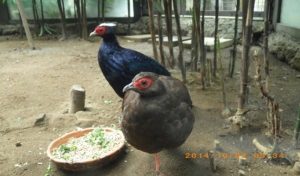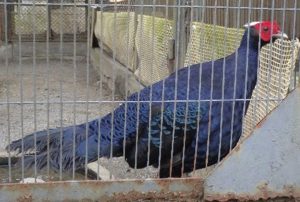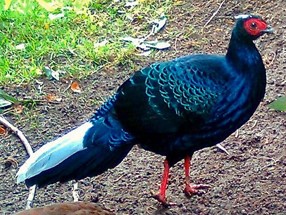Current Status and Future Prospectus of Maintaining Edwards’s Pheasant (Lophura Edwardsi)
Tama Zoological Park
Kyoko Matsumoto
On the brink of extinction
The sole habitat of the Edwards’s pheasant (Lophura edwardsi) is in the forests 600 m above sea level in central Vietnam. Both males and females have bare red skin on their faces, with males having a shiny bluish-purple color on their entire body and females having a uniformly brown color on their entire body. Their colors may appear drab at first glance when compared to pheasants with various morphologies and feather colors, such as the peafowl and golden pheasant, but the Edwards’s pheasant is a bird with unique beauty, such as males having scale patterns on their monochromatic feathers depending on how the light hits them (Fig. 1).

Fig. 1. Male (back) and female (front) Edwards’s pheasants
This species, which is endemic to Vietnam, has been declining rapidly for decades due to the impacts of pressure from hunting and decreases in the area of its habitats due to deforestation, with the International Union for Conservation of Nature (IUCN) Red List designating the species as “Critically Endangered”, which signifies the highest risk for extinction in the wild. Since 2000, the only two reliable sightings of this species in their habitat were that of a male that died when caught in a trap in Hai Lang district, and that of an individual in a cage of a farmer in the same district in 2009; and it has been suggested that the number of wild individuals is either extremely small, or they have already gone extinct. Currently, the Edwards’s pheasant is listed in Appendix I under the Convention on International Trade in Endangered Species of Wild Fauna and Flora (CITES), and international trade of this species is severely restricted.
The existence of this species has hardly been confirmed in its habitat, but approximately 1,000 individuals have been bred in many breeding facilities, including zoos, worldwide. Today, facing the threat of extinction in the wild, the Edwards’s pheasant can be said to be quietly continuing to survive in the Noah’s Ark, that is in “captivity” so as not to go extinct. In the future, when the habitat environment improves, the possibility of reintroducing the captive-bred population back into the wild may be considered, but we must stay vigilant over the breeding situation of the Edwards’s pheasant.
Challenges of successive breeding
Male Edwards’s pheasants may become aggressive when adult males and females live together, so they are kept in captivity individually as a general rule, and breeding is preferably done by having the males and females living together prior to the breeding age. Therefore, securing a captive location has become a major challenge for successive breeding in recent years.
The general rule in Japanese zoos is to keep aged individuals in captivity for their entire lives, doing so even when they are no longer able to breed. Therefore, when the cages of the aged individuals become fully occupied as captive locations, then active breeding becomes difficult, and breeding restrictions become inevitable. In fact, it is often the case with many domestic captive animals, not just with the Edwards’s pheasant, that breeding facilities become fully occupied in captive locations of aged individuals, and breeding-age individuals lose their fertility while breeding restrictions are put in place.
The number of long-lived animals is increasing due to improved breeding techniques, but it is extremely difficult for a single breeding farm to satisfy the conditions of having breeding-age individuals breed at an optimal timing, and secure sufficient captive locations for a breeding pair of the next generation to form among the young individuals. Multiple zoos must mutually supplement captive locations and secure them while maintaining a “single captive population”.
In order to resolve this problem, the Japanese Association of Zoos and Aquariums (JAZA) has been formulating the JAZA Collection Plan (JCP) since FY 2013. JCP involves the selection and prioritization of animal species with the aim of systematically maintaining populations in order to effectively utilize limited captive spaces in Japan, with the need for conservation, educational value, academic value, and exhibition effects set as indicators.
As of 2016, the Edwards’s pheasant has been designated as a JSMP species (managed species), which signifies that it is the most important species for population management in the JCP of pheasants; however, a higher prioritization does not necessarily secure breeding facilities.
The collection and exhibition plan of each zoo can be determined by each local government or company that is the operating body of the zoo, and the exhibition plan of each zoo cannot be changed with the JCP prioritization alone. Furthermore, there are some species that require a wider breeding location from the perspective of animal welfare, and there are many zoos that reduce the number of breeding location areas of pheasants while securing breeding locations for other large animals. Therefore, the number of domestic facilities that are capable of breeding pheasants has tended to decrease every year, and the current status is such that securing sufficient breeding locations for the pheasant has been difficult despite the species having highest priority.
Review of classification of Edwards’s pheasants
Another challenge is the question of whether it is possible to maintain a population with sufficient genetic diversity. According to pedigree registers in Europe, there was a significant decrease in numbers of captive birds from 1942 to 1947, after which populations were maintained from a pedigree derived from the same single female, therefore, the European captive populations cannot be considered to have high genetic diversity. Furthermore, many captive populations in Japan originate from breeding facilities in Europe when tracing back their pedigrees, and it cannot be considered that a sufficient genetic diversity has been maintained. Therefore, a review of the classification of the Edwards’s pheasant has led to a focus on the Vietnamese pheasant (Lophura hatinhensis), which has a remarkably high possibility of being the same species as the Edwards’s pheasant.
The Vietnamese pheasant inhabits the mountainous areas of Vietnam, which are also the habitats of the Edwards’s pheasant. Similar to that for the Edwards’s pheasant, there are few research cases of the Vietnamese pheasant in the wild, and its detailed ecology has not been clarified, but international pedigree registration ledgers indicate that about 260 individuals are kept captive worldwide.
The morphological characteristics are very similar to that of the Edwards’s pheasant, and the appearance characteristics are almost identical, except for the central tail feathers being white in the Vietnamese pheasant (Fig. 2, Fig. 3). Therefore, as a general rule, domestic and international breeding facilities have ensured that the two species are not kept captive in the same facility so that hybrids are not born between the two species.
However, recent research has shown that the Vietnamese pheasant emerged from the Edwards’s pheasant in some fragmented habitats due to mutations, and the prevailing view is becoming that the two species are highly likely to genetically be the same species.
A pedigree registration survey of Vietnamese pheasants in Japan that was conducted in order to support these theories showed that 16 out of 30 individuals had a feather color similar to that of the Edwards’s pheasant, where the white part of the tail feather was absent. Additionally, despite there being no cases of Vietnamese pheasants in captivity in the United States, Edwards’s pheasants with a white color in their tail feathers have been reported.
Previous studies have clarified that the Vietnamese pheasant contains several alleles that are lost in the Edwards’s pheasant population, and if these two species are the same, then this may be an opportunity to increase the genetic diversity of captive Edwards’s pheasant populations.

Fig. 2. Male Edwards’s pheasant

Fig. 3. Male Vietnamese pheasant
Currently, the taxonomic positions of the Edwards’s pheasant and the Vietnamese pheasant have not been clarified, therefore a specific policy on the handling of captive populations has not yet been determined. However, if future research results clarified the genetic relationship between Edwards’s pheasants and Vietnamese pheasants and identified them as the same species, then it may be possible to treat captive Edwards’s pheasants and Vietnamese pheasants as the same species and increase the genetic diversity of captive populations.
The fate of the Edwards’s pheasant, which has almost disappeared from its habitat and is on the brink of extinction, rests on the continuation of successive breeding in breeding facilities and future research results.
References
IUCN Red List 2016,
http://www.iucnredlist.org/details/45354985/0
BirdLife International. 2016,
http://www.birdlife.org/datazone/species
Alain Hennache, Edwards’s Pheasant Studbook Lophura edwardsi 2007 International, Data current as of 31 January 2008.
Alain Hennache, Vietnamese Pheasant Studbook Lophura hatinhensis 2007 International, Data current as of 31 décembre 2007
Arkive.org
http://www.arkive.org/vietnamese-pheasant/lophura-hatinhensis/#src=portletV3api

